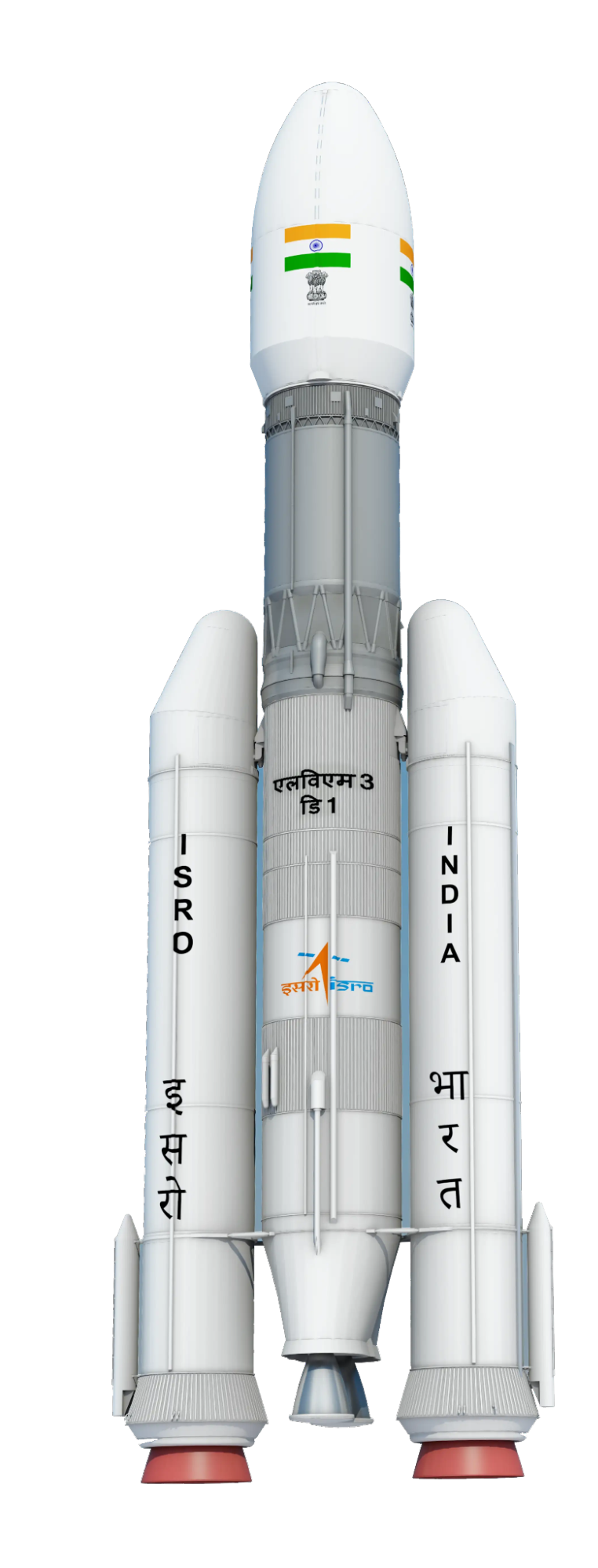GSAT-7R: India’s Heaviest Naval Communication Satellite | 03 Nov 2025
Why in News?
The Indian Space Research Organisation (ISRO) successfully launched GSAT-7R (also known as CMS-03), India’s heaviest indigenously built advanced communication satellite, from Satish Dhawan Space Centre (SDSC), Sriharikota marking a major boost to the country’s space capabilities and naval communications.
What are the Key Facts About the CMS-03 (GSAT-7R)?
- About: The CMS-03 was successfully launched using the Launch Vehicle Mark-3 (LVM3) on its fifth operational flight (LVM3-M5).
- CMS-03 is a multi-band communication satellite that will provide services over a wide oceanic region including the Indian landmass.
- CMS-03, weighing about 4400kg, is the heaviest communication satellite launched to Geosynchronous Transfer Orbit (GTO) from India.
- The previous mission of LVM3 launched the Chandrayaan-3 mission, where India became the first country to land successfully near the lunar south pole.
- Technical Features: The satellite has been placed in a GTO and will later move into its final Geostationary Orbit using its onboard propulsion system.
- Designed for a 15-year mission life, CMS-03 carries advanced multiband transponders that transmit voice, data, and video signals, ensuring secure, high-capacity communication for the Indian Navy across the Indian Ocean Region (IOR).
- Significance: The GSAT-7R replaces the decade-old GSAT-7 (Rukmini), launched in 2013, which has now reached the end of its operational life.
- This new satellite is fully indigenously developed, symbolising progress under Aatmanirbhar Bharat.
- LVM3-M5 strengthens India’s strategic autonomy and reduces reliance on foreign launch vehicles for heavy payloads such as the European Ariane-5.
- It supports Gaganyaan preparations by showcasing LVM3’s heavy-lift capability and cryogenic engine re-ignition test for future missions.
Launch Vehicle Mark (LVM)-3
- About: LVM-3, earlier referred to as Geosynchronous Launch Vehicle Mark 3 or GSLV Mk 3, uses solid, liquid, as well as cryogenic-fuel based engines to put up to 8,000 kg in low earth orbit (LEO) (up to an altitude of 2,000 km from Earth’s surface) and up to 4,000 kg in geosynchronous orbit (about 36,000 km).
- Major Achievements: Successfully launched Chandrayaan-2 and Chandrayaan-3 lunar missions
- It carried India’s first crew module (2014) for re-entry test under Gaganyaan programme
- Launched 72 OneWeb satellites in 2022 to LEO amid the global shortage of launch options caused by the Russia-Ukraine war.
- These missions showcased its adaptability and led ISRO to rebrand it from “GSLV Mk-3” to “LVM-3.”
- Upgrades and Future Enhancements: ISRO is upgrading the LVM-3 for future missions like the Bharatiya Antariksha Station and lunar exploration.
- Plan to replace the liquid stage with a semi-cryogenic engine using refined kerosene and liquid oxygen.
- These enhancements could raise its payload to 10,000 kg in LEO.
- ISRO is also developing the next-gen Lunar Module Launch Vehicle (LMLV) to carry up to 80,000 kg, positioning LVM-3 as the “Bahubali rocket” driving India’s deep-space and human spaceflight ambitions.
Frequently Asked Questions (FAQs)
1. What is GSAT-7R (CMS-03)?
GSAT-7R (CMS-03), an indigenously built multiband communication satellite for the Indian Navy, was launched by the LVM-3 (M5) rocket from Sriharikota to GTO to provide secure voice, data, and video links across the Indian Ocean Region.
2. What milestone did LVM-3 achieve in the GSAT-7R (CMS-03) mission?
ISRO re-ignited the C25 cryogenic stage after satellite separation, a first for India, allowing multi-orbit deployment in future missions.
3. What is the payload capacity of LVM-3?
LVM-3 can launch up to 8,000 kg to Low Earth Orbit (LEO) and up to 4,000 kg to Geosynchronous Orbit (GEO).
4. What were previous major missions of LVM-3?
LVM-3 launched Chandrayaan-2, Chandrayaan-3, and 72 OneWeb satellites (2022) to Low Earth Orbit.
UPSC Civil Services Examination, Previous Year Question (PYQ)
Prelims
Q. With reference to India’s satellite launch vehicles, consider the following statements: (2018)
- PSLVs launch the satellites useful for Earth resources monitoring whereas GSLVs are designed mainly to launch communication satellites.
- Satellites launched by PSLV appear to remain permanently fixed in the same position in the sky, as viewed from a particular location on Earth.
- GSLV Mk III is a four-staged launch vehicle with the first and third stages using solid rocket motors; and the second and fourth stages using liquid rocket engines.
Which of the statements given above is/are correct?
(a) 1 only
(b) 2 and 3
(c) 1 and 2
(d) 3 only
Ans: (a)
Q. Consider the following statements: (2016)
The Mangalyaan launched by ISRO
- is also called the Mars Orbiter Mission
- made India the second country to have a spacecraft orbit the Mars after USA
- made India the only country to be successful in making its spacecraft orbit the Mars in its very first attempt
Which of the statements given above is/are correct?
(a) 1 only
(b) 2 and 3 only
(c) 1 and 3 only
(d) 1, 2 and 3
Ans: (c)

